A SEASON OF MORE UPS THAN DOWNS?
Wild weather this winter disrupted, shortened, and extended the season, depending on your location. How would these constant ups and downs affect visitation and revenue? Would lost operating days and rough holiday periods in parts of the country skew the national results downward? Or did headline-dominating historic snow in the West—and continued demand despite lean snowfall elsewhere—drive another historic season, pulling the grade up?
To get to the bottom of the mystery, in April, SAM polled readers for their best estimates regarding visitation and revenue at their respective areas as well as total U.S. skier visits.
Total skier visits. Many of you speculated that this season would wrap up similarly to last season in terms of national visitation, with 30.2 percent of survey respondents estimating between 59.1-61 million skier visits.
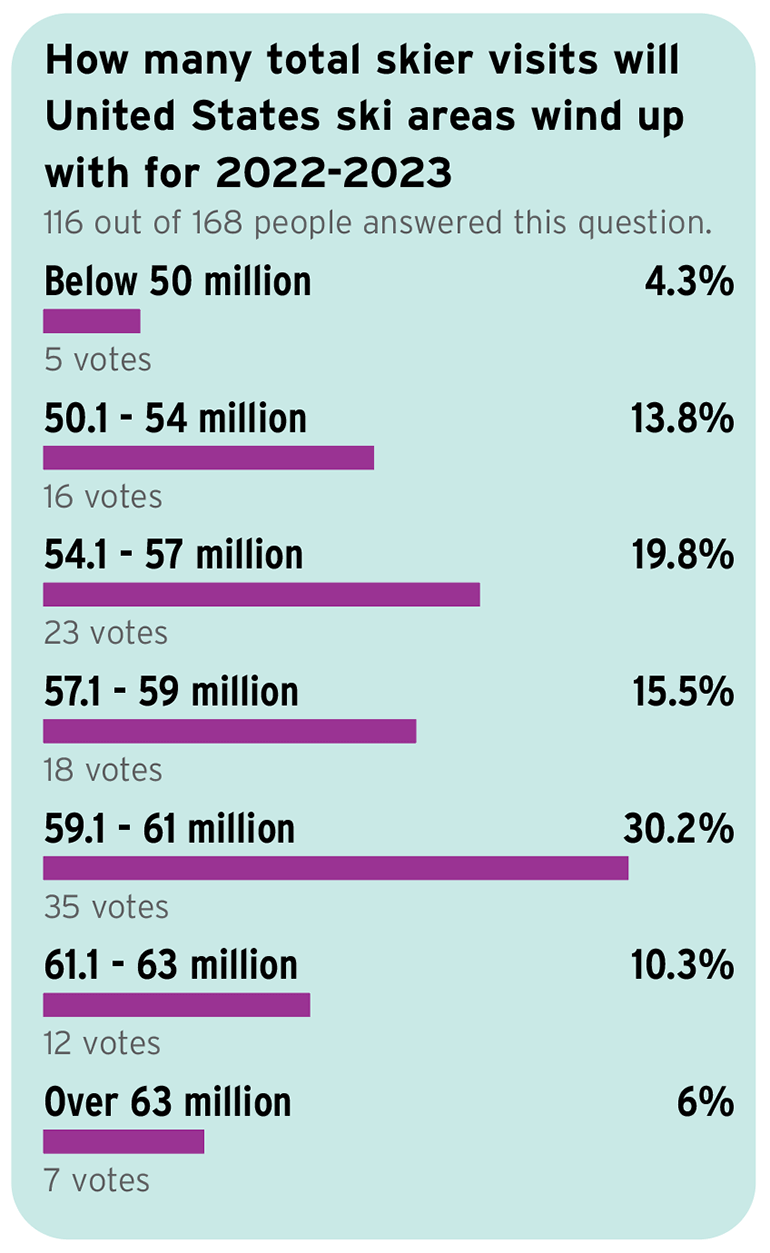
More than 50 percent of respondents forecast fewer skier visits than last year’s record-setting total, though. Of that 50 percent, nearly 20 percent estimated 54.1-57 million skier visits total, and 15.5 percent estimated 57.1-59 million skier visits.
That more conservative position was reflected by one survey respondent who suggested that business was “tempering and [we are experiencing] a return to more normal, pre-pandemic patterns.”
“Extreme weather (too much snow and no snow) across the country has impacted visitation,” said another respondent. This sentiment was widely echoed in other survey responses.
“Too much snow was bad for business,” said one respondent. And, on the opposite end of the spectrum, it was a “rough start in the East—March snow [arrived] too late to make up for lost time,” said another.
In terms of the overall portrait of the season, it was “challenging with some places not getting enough snow and cold, and others getting more than they want,” one respondent observed.
In addition to the weather, several other factors are likely to influence visitation and revenue for the season, according to respondents. With travel now unrestricted, ski areas were once more, “competing against international destinations and cruises this winter,” noted one. “Costs [are] rising faster than revenue,” added another.
Revenue. When it comes to revenue, nearly 57 percent of respondents estimated their business was going to be up year-over-year.

Of course, it’s important to note that revenue is not profit and, as one respondent noted, “expenses are up.” Increased wages and energy costs likely contributed to increased expenses, as did weather disruption in many regions (there are going to be a lot of shoveling hours on a lot of paychecks).
Still, it seems likely that robust pass sales, improved ancillary revenue, and cost saving measures will insulate most ski areas against catastrophic profit loss and many may fare quite well despite lackluster weather. Consider this respondent, who said: the season was “good from the standpoint that lots of passes were sold and operational costs were saved due to slow start and early conclusion.”
Visitation. As for visitation at individual resorts, while “great snow always helps,” as one respondent noted, variable conditions aren’t the death knell they once were. “It was a good season despite the weather/lack of natural snow,” said one respondent. “Tough weather in the East but guests came anyway,” said another.
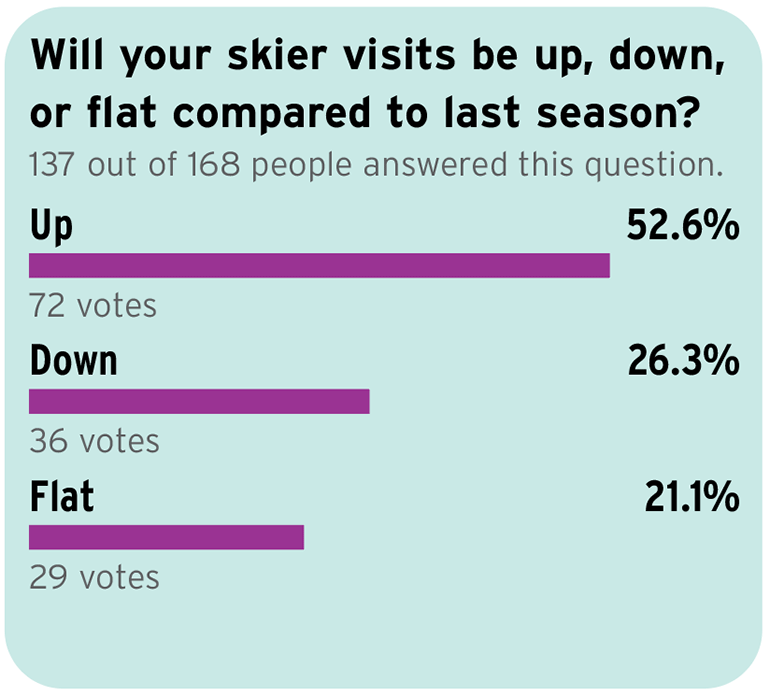
When asked whether skier visits at their resort would be up, down, or flat year-over-year, nearly 53 percent of respondents estimated visits would be up while 21 percent expected their visits to remain flat. Given the variability of the season across the country, that’s not a bad showing.
And let’s be real, many had an unapologetically good year. As one respondent put it, the season, for many, was “Bitchin’. ”
On the flip side, more than a quarter of respondents (26 percent) estimated their skier visits would be down for the season. Even if the season was a “rollercoaster,” though, as many described it, it was “a worthwhile struggle.”
FRENCH CONNECTION
In mid-February, SAM was part of a small delegation of United States ski area leaders that visited the French Alps on an “innovation mountain tour” hosted by Cluster Montagne, an association that represents and promotes French know-how for sustainable mountain tourism development. We met with leaders of the French ski industry—both ski area operators and suppliers—for five whirlwind days, and came home with a better understanding of our shared challenges and opportunities, as well as the differences between how our ski areas run.
Our group consisted of Katie Ertl, senior VP of mountain operations, Aspen Snowmass, Colo.; Guy Lawrence, general manager, Summit at Snoqualmie, Wash.; Nate Lee, VP of resort operations, Solitude, Utah; Brad Wilson, general manager, Bogus Basin, Idaho; and SAM editor Dave Meeker. Our tour leader was Cluster Montagne’s Benoit Robert, an exceptional representative of his country and the industry.
Here are some of the group’s lessons learned and observations about the French ski industry.
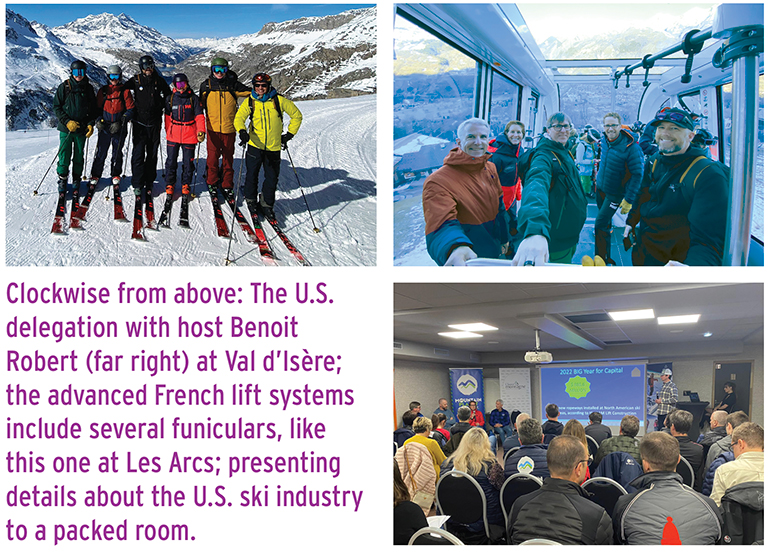
Different Business Structure
French law dictates that ropeways are a public service, so the mayor of the municipality located at the base of a ski area oversees that ski area. In most cases, mayors choose to delegate the operation of the ski area to a private company—such as Compagnie des Alpes, which runs 10 major resorts in France—but, per French law, the mayors still have the final say on investments, such as the location and type of new lift installations and lift ticket pricing. This means politics are an inherent part of the French ski industry.
Whether the municipality or a private company operates the ski area, the scope of operations, for the most part, only includes the ropeways, grooming, snowmaking, and patrol/security.
Independent ancillaries. As such, any lodging, food and beverage, rental, and retail establishments on-site are independent. They operate at the resort, but have no direct affiliation—financial or otherwise—with the ski area business.
The same goes for ski and snowboard schools. There are several independent ski and snowboard schools in France, which have agreements to operate at various resorts. These businesses do not pay to use resort terrain, nor do they share any of the financial burden of snowmaking, grooming, or lift operations, yet resort operators typically maintain top-notch learning areas for their use.
Pricing and costs. France has the lowest lift ticket prices in the world—an average of only €45 per day, according to Laurent Reynaud, managing director at Domaines Skiables de France (the French equivalent of NSAA). This is both a source of pride and concern among industry players.
Mayors want to keep skiing affordable and don’t want to raise prices too quickly, for fear of losing business. Pricing isn’t keeping pace with costs, though. The price of electricity has quadrupled since before Covid due to a variety of factors, including the war in Ukraine. A new detachable lift or gondola costs 36 percent more now than before Covid, too—and French ski areas install an average of 60 new ropeways a year nationwide.
Climate And Sustainability
At the time of our visit, the French Alps were experiencing one of their leanest snow years in a long time. The terrain at higher elevations—above 5,000 feet or so—was fully covered, but some ski areas at lower elevations had closed due to the lack of snow and snowmaking conditions.
The industry itself is quite responsive to the need to adapt to climate change and operate more sustainably. But its efforts in doing so haven’t been publicized effectively. According to Renault, more than 80 percent of French people have a positive view of skiing, but also think that skiing is going to go away soon due to climate change, and that the ski industry is bad for the environment.
“[French operators] admittedly have some room to grow in how they use PR to message what they are doing to combat CO2 emissions and education of the communities and agencies that are against skiing as a recreational activity,” observes Aspen’s Ertl.
“Sustainability is a very big focus—and understandably so, as global warming is occurring on a faster, more evidential pace in Europe,” adds Snoqualmie’s Lawrence. “But they also face a lot of political and public pressure, as the general perception is that they’re big contributors to climate change.”
Proactive steps. Domaines Skiables de France and other industry organizations are now running campaigns focused on promoting the ski industry’s sustainability efforts in a bid to change the public perception.
And there’s a lot of PR ammo to combat that perception. The industry came together to produce an environmental roadmap with various sustainability objectives and commitments, which includes French ski areas achieving carbon neutrality by 2037 through various efforts, such as investments in on-site power production—mostly pumped storage hydro power.
Compagnie des Alpes also now runs all 130 snowcats in its multi-resort fleet with HVO100 synthetic fuel. “The one thing that stood out the most for me was how far down the rabbit hole they all are on sustainability—having all snowcats running on a recycled energy source is amazing,” says Solitude’s Lee.
Technology
Everyone in our group took note of the various technologies in place at the resorts we visited, especially the ropeways. Multiple gondolas, big chairs, cable cars, funiculars—exotic uphill transport is a specialty of French ski resorts. “The lift technology and infrastructure is astounding in comparison to the United States,” says Lawrence.
“The sheer amount and variety of their lift systems was amazing,” says Bogus Basin’s Wilson. And Lee “was shocked at the size of their lift infrastructure; it was very rare to see a chair smaller than a six pack.”
Lift loading. While the lifts were impressive, loading them was a different experience than it is in the States. French resorts all use RFID to access the lifts, but queuing was a free-for-all, which would never fly at U.S. ski areas.
“One operator at the base of each lift, and no line organization, made for an interesting experience,” says Wilson. “The lack of organization negatively impacted their ability to maximize uphill capacities and added to the length of their lines.”
Signage. Other technology implementations were more geared toward a smoother guest experience. For example, Ertl took note of the digital signage that was prevalent at the resorts. “I appreciate the digital maps at most locations, which made it easy to see what’s open and where,” she says. “I also enjoyed the digital boards above lift entrances—not new, but helpful.”
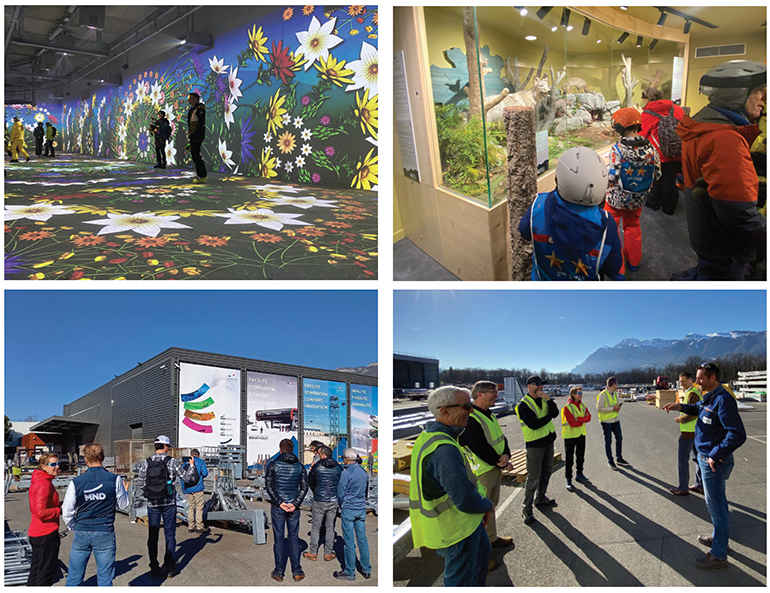 Clockwise from top left: A digital exhibition inside a gondola cabin storage facility at Les Arcs is a brilliant use of space; instructors take kids into the on-site natural history museum at Les Arcs for breaks during ski lessons; a tour of the Poma factory where ropeways are manufactured from raw metal into ready-for-assembly parts and peices; the MND Group factory tour detailed the breadth of products the company produces.
Clockwise from top left: A digital exhibition inside a gondola cabin storage facility at Les Arcs is a brilliant use of space; instructors take kids into the on-site natural history museum at Les Arcs for breaks during ski lessons; a tour of the Poma factory where ropeways are manufactured from raw metal into ready-for-assembly parts and peices; the MND Group factory tour detailed the breadth of products the company produces.
Mega Pass Interest
Visitation to French ski resorts has been flat in recent years, hovering around 55 million skier visits a year. The decline in youth participation is a major concern. Industry players are looking for solutions.
Our delegation conducted a presentation about the U.S. ski industry to a room full of ski area operators, elected officials, suppliers, and press. We took questions throughout, and the topic of greatest interest was our multi-property season pass products, such as Epic and Ikon.
Why? They see the news about crowding at U.S. ski areas and that the industry had record skier visits in 2021-22. They see how popular season passes are here in the States and wonder if it’s an option for them. Only 10-15 percent of skier visits in France are from season passes, compared to 53 percent in the U.S.
From the French perspective, it’s hard to fathom why visitation is growing in the United States given the astronomical cost of skiing here. While the equation is complicated, most major U.S. resorts charge eye-popping daily ticket prices to make the upfront outlay for a season pass a better value for guests who plan (or hope) to ski multiple times a season.
A viable model? Could mega-passes help spur visitation in France? Overarching forces at play may preclude the development of such products. Cheap lift tickets and strong technology that makes it easy to book a ticket online make having a season pass less necessary, and political entanglements involved in the decision-making at each resort could be difficult to work through.
Other Takeaways
Après ski in France is legit. Places like La Folie Douce (with seven resort locations), where the music is loud and people dance on tables in ski boots (the stuff of nightmares for American risk managers), are fun and add a whole other element to the overall experience. These après spots have a party atmosphere, but there were plenty of families around enjoying it, too. Ski areas in the U.S. could adopt something similar if their visitor set calls for it.
Creative uses of space. Les Arcs had a company create an immersive “digital exhibition” inside the cabin storage building at the top of its Varet gondola. The floors and walls come alive with hi-def digital projections accompanied by crisp sound that take you through the seasons. Access will be included in the cost of a lift pass next winter. It’s a good example of capitalizing on an unused space to enhance the overall visit experience.
Les Arcs also built a small but thorough museum of natural history inside a building located right next to its primary learning area. The free experience is like a zoo with taxidermied native animals in their natural setting, and kid-sized interactive educational features. Ski instructors use breaktime to bring their students into the museum, and the kids love it. Another experience enhancer that U.S. ski areas could implement.
We can learn from each other. Despite the operational differences, U.S. and French ski areas share several of the same challenges, such as climate change, staffing and staff housing, aging participation, and more. Our small delegation took home several actionable items they planned to present at their own operations, none of which would have been learned had they not engaged with French operators. The goals of the trip were to share, learn, and expand our respective networks. Mission accomplished.
SUPPLIER NEWS
Aurélien Bône has been appointed to the role of director of sales, communication, and group marketing for MND.
Bo Adams will be retiring after nearly 45 years with the MOUNTAINGUARD program. Adams started with the MountainGuard team in 1978. He was promoted to senior vice president in 1989 and has co-managed the MountainGuard program’s sales efforts and operations since.
Troy Hudson has joined ENTABENI SYSTEMS as its Canadian manager, supporting Entabeni’s technology offerings for small and independent ski areas in the Canadian market.
CHS SNOWMAKERS partnered with software developer E4Soft to create a new technology solution aimed at standalone snow tubing hills, cross country ski centers, and adventure parks for ticketing, retail, F&B, and other areas of operation.
PC CONSTRUCTION won the National AGC Build America Award for the construction of One Spruce Peak, a residential mountain retreat at Stowe Mountain, Vt.
Tim Samson has joined CATALATE as director of sales in North America.
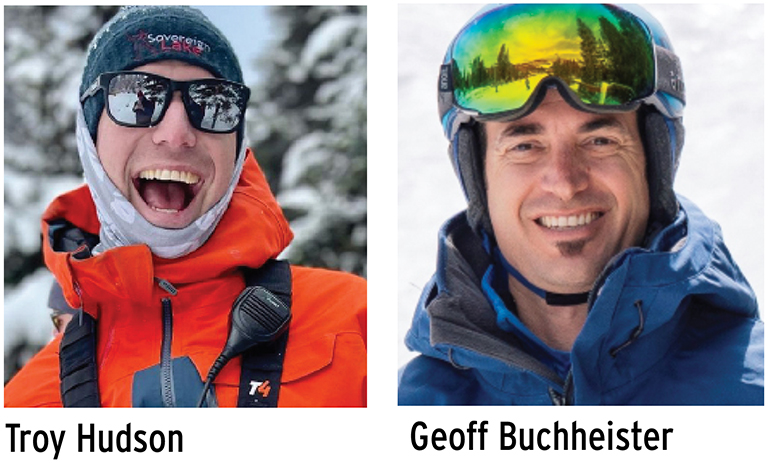
PEOPLE
In Colorado, Aspen Skiing Company named Geoff Buchheister CEO of Aspen Snowmass. … Bill Rock was elevated to the role of president of Vail Resorts mountain division; Nadia Guerriero succeeded Rock as SVP and COO of the Rockies region. ... Vail Mountain promoted Shawn Carney to director of activities, race, events, and terrain parks.
Sarah Sherman rejoined Snowbird, Utah, as communications manager, and Riley Whitney was hired as the resort’s communications coordinator. … Stephen Helfenbein is now director of snowsports and guest services for Sun Valley, Idaho.
Gogebic Community College Ski Area Management director and Mt. Zion Ski Area (Mich.) manager Jim VanderSpoel is retiring. … Kent Ebersole was promoted to president of the Outdoor Industry Association.
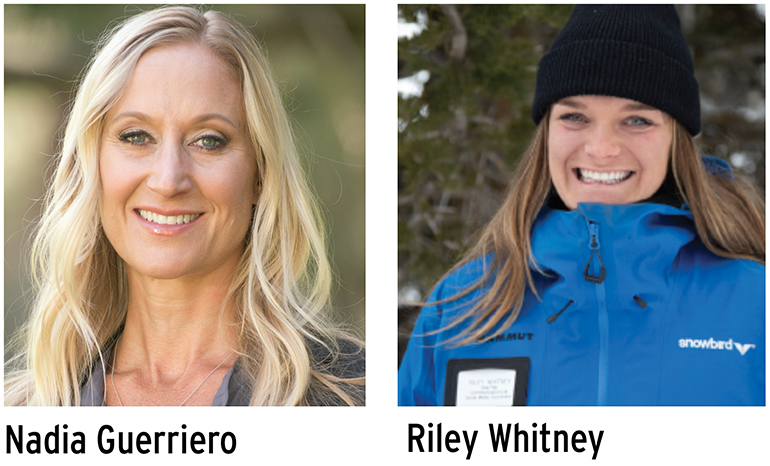
AWARDS
Mt. Hood Meadows, Ore., was named a U.S. Best-in-Class Employer by Gallagher’s 2022 U.S. Benefits Strategy & Benchmarking survey for the second consecutive year. … SNOW Partners, parent company of SNOW Operating, SnowCloud, Mountain Creek and Big SNOW American Dream (N.J.), was recognized as a top place to work by the Top Workplaces USA and Top Workplaces New Jersey surveys.
Fast Company selected Taos Ski Valley, N.M., as one of the World’s Most Innovative Companies for 2023 for the resort’s environmental and social responsibility work.
The U.S. National Ski & Snowboard Hall of Fame inducted 18 new members at its annual ceremony, held in Big Sky, Mont. Among the honorees were snowmaking and ski area pioneer Herman Dupré (class of 2021), Olympian Bode Miller (class of 2018), former Alterra Mountain Company CEO Rusty Gregory (class of 2022) and Ski Racing magazine founder Gary Black Jr. (class of 2022).
OBITUARIES
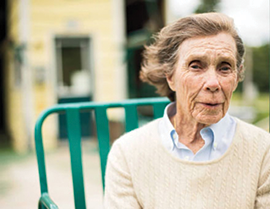 Betsy Pratt, former owner of Mad River Glen, Vt., died March 17, 2023, at the age of 95. Pratt, her husband, and other investors purchased the ski area in 1972. Pratt played a key role in converting the ski area to a cooperative, and Mad River Glen remains the only cooperatively owned ski area in the United States. She was recognized as a pioneer in the industry and inducted into the Hall of Fame at the Vermont Ski and Snowboard Museum in 2022.
Betsy Pratt, former owner of Mad River Glen, Vt., died March 17, 2023, at the age of 95. Pratt, her husband, and other investors purchased the ski area in 1972. Pratt played a key role in converting the ski area to a cooperative, and Mad River Glen remains the only cooperatively owned ski area in the United States. She was recognized as a pioneer in the industry and inducted into the Hall of Fame at the Vermont Ski and Snowboard Museum in 2022.






